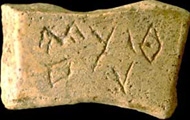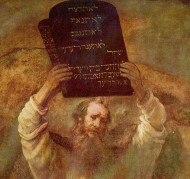Religious Texts
Introduction
The appearance of all religious texts occurred through a human agent. Nevertheless, in almost all cases (if not all), adherents claim divine inspiration for their scripture and consider them sacred. In most religions, the information was transmitted orally before it was written.
Writing
 The earliest writing samples of religious texts date to between 3,400 and 3,500 BC. They were discovered from locations of ancient civilizations in Egypt and the Indus Valley (covering the areas of India, Pakistan, and Afghanistan). Early forms of writing used wood, stones, pottery, and clay tablets, before paper was invented. Peoples at those times wrote using symbols and hieroglyphs. The early writing from Mesopotamia and Egypt is related to trading that occurred among the civilizations in those areas. It is likely that writing evolved to record human interactions and environmental events when memory could no longer meet the demands of an increasingly complex society.
The earliest writing samples of religious texts date to between 3,400 and 3,500 BC. They were discovered from locations of ancient civilizations in Egypt and the Indus Valley (covering the areas of India, Pakistan, and Afghanistan). Early forms of writing used wood, stones, pottery, and clay tablets, before paper was invented. Peoples at those times wrote using symbols and hieroglyphs. The early writing from Mesopotamia and Egypt is related to trading that occurred among the civilizations in those areas. It is likely that writing evolved to record human interactions and environmental events when memory could no longer meet the demands of an increasingly complex society.Translation
Translation from one language to another always runs a risk of changing the meaning or flavor of the original text. When the initial story is related orally, details and implications can change from one person to the next. Writing down the story in text can be greatly influenced by the individual(s) chosen as source.
Judaism
The Tanakh (Jewish Bible) was written primarily in Biblical Hebrew. During the first Babylonian exile of the Jews in the 6th century B.C.E, some of the first translations began, producing non-literal translations or paraphrases known as targums, primarily in Aramaic, which was commonly spoken by the Jews at the time. In the 3rd century B.C.E., a Greek translation was produced known as the Septuagint (after the approximately 70 persons translating). From the 9th century to the 15th century, Jewish scholars added vowel points to the text, which previously contained only consonant letters. The process sometimes required the selection of an interpretation, since some words differed only in their vowels and their meaning could vary in accordance with the vowels chosen. Other variations that have survived include the Samaritan Pentateuch, the Dead Sea scrolls, and other ancient fragments.
Christianity
The New Testament books were written in Greek, although some of the text may have been translated from Hebrew or Aramaic originals. The duplication of the first manuscripts by scribes introduced variations in the copies from the original. About 400 C.E, a Latin translation was produced. On the whole, most versions of the Christian canon contain the same text, but there are some variations. For instance, the book of Revelation was not initially included in the canon, as well as other writings. Deuterocanonical books were part of early translations, are not found in the Hebrew Bible, but are accepted in a second canon by the Roman Catholics. These deuterocanonical books are called apocrypha by Protestants.
Subsequent translations differed in the source used to make the translation: Greek, Latin, Hebrew, etc. Moreover, translations made for particular branches of Christianity have been made to conform with the group's theology when other translations did not.
All languages have idioms and concepts that challenge translation into other languages. As a result, there is disagreement about whether to translate as literally as possible, perhaps making it difficult to understand the intent of the writer, or to give a parallel idiom in the target language to preserve the meaning of the original passage. People disagree on which approach most accurately communicates the message of the Bible.
Islam
Muslims believe that the Qur'an was revealed from Allah to Muhammad orally through the angel Jibril (Gabriel) over a period of approximately twenty-three years, beginning in 610 C.E., when he was forty, and concluding in 632 C.E., the year of his death. They believe the Qur'an to be the literal word of God.
Muslims further believe that the Qur'an was memorized, recited and written down by tens of thousands of Muhammad's companions after every revelation dictated by Muhammad. The Qur'an was established textually into a single book form shortly after Muhammad's death. A single authoritative text was made in the standard dialect (Modern Standard Arabic), and all other versions were burned.
CanonThe Tanakh (Jewish Bible) was written primarily in Biblical Hebrew. During the first Babylonian exile of the Jews in the 6th century B.C.E, some of the first translations began, producing non-literal translations or paraphrases known as targums, primarily in Aramaic, which was commonly spoken by the Jews at the time. In the 3rd century B.C.E., a Greek translation was produced known as the Septuagint (after the approximately 70 persons translating). From the 9th century to the 15th century, Jewish scholars added vowel points to the text, which previously contained only consonant letters. The process sometimes required the selection of an interpretation, since some words differed only in their vowels and their meaning could vary in accordance with the vowels chosen. Other variations that have survived include the Samaritan Pentateuch, the Dead Sea scrolls, and other ancient fragments.
Christianity
The New Testament books were written in Greek, although some of the text may have been translated from Hebrew or Aramaic originals. The duplication of the first manuscripts by scribes introduced variations in the copies from the original. About 400 C.E, a Latin translation was produced. On the whole, most versions of the Christian canon contain the same text, but there are some variations. For instance, the book of Revelation was not initially included in the canon, as well as other writings. Deuterocanonical books were part of early translations, are not found in the Hebrew Bible, but are accepted in a second canon by the Roman Catholics. These deuterocanonical books are called apocrypha by Protestants.
Subsequent translations differed in the source used to make the translation: Greek, Latin, Hebrew, etc. Moreover, translations made for particular branches of Christianity have been made to conform with the group's theology when other translations did not.
All languages have idioms and concepts that challenge translation into other languages. As a result, there is disagreement about whether to translate as literally as possible, perhaps making it difficult to understand the intent of the writer, or to give a parallel idiom in the target language to preserve the meaning of the original passage. People disagree on which approach most accurately communicates the message of the Bible.
Islam
Muslims believe that the Qur'an was revealed from Allah to Muhammad orally through the angel Jibril (Gabriel) over a period of approximately twenty-three years, beginning in 610 C.E., when he was forty, and concluding in 632 C.E., the year of his death. They believe the Qur'an to be the literal word of God.
Muslims further believe that the Qur'an was memorized, recited and written down by tens of thousands of Muhammad's companions after every revelation dictated by Muhammad. The Qur'an was established textually into a single book form shortly after Muhammad's death. A single authoritative text was made in the standard dialect (Modern Standard Arabic), and all other versions were burned.
A Biblical canon is the group of writings that define the religion, considered to either be given directly, or otherwise inspired, by God, generally in Judaism or Christianity. Religious authorities have debated and decided which writings can be included in the canon. However, different branches of the religion differ in which writings have been included in their own versions of the canon. Moreover, there may be multiple versions of the manuscript in different languages, each with its particular ways of expressing ideas associated with the respective language.
Interpretation
 Some original religious texts were composed from transcripts from oral traditions. Others were written over hundreds of years by multiple authors, some of whom may not have been the nominal author of the document. For instance, scholarly analysis revealed that Moses was not the author of the Pentateuch (the first five books of the Bible whose authorship was ascribed to Moses, and comprise the Jewish Torah). Various religious groups differed in which writings they included as sacred texts and which they rejected, although Judaism, Christianity, and Islam all include the first five books of the Bible among their sacred writings.
Some original religious texts were composed from transcripts from oral traditions. Others were written over hundreds of years by multiple authors, some of whom may not have been the nominal author of the document. For instance, scholarly analysis revealed that Moses was not the author of the Pentateuch (the first five books of the Bible whose authorship was ascribed to Moses, and comprise the Jewish Torah). Various religious groups differed in which writings they included as sacred texts and which they rejected, although Judaism, Christianity, and Islam all include the first five books of the Bible among their sacred writings.On the basis of the historical and stylistic content in the first five books of the Bible, scholars expressed a "documentary hypothesis" that gave an historical framework for the composition of the documents and their collection into the Pentateuch: that the Torah was written by different people at different times—generally long after the events it describes—and that the Bible was a body of literature more than a work of history. They suggested that the historical value of the text lies, not in its account of the events that it describes, but in what critics can infer about the times in which the authors lived (as critics may read Hamlet to learn about seventeenth-century England, but will not read it to learn about seventh-century Denmark).
Excerpted and adapted from: First Written Language, Three Early Biblical Translations, The Torah of Moses, Bible translations, Writing
Religious text, Scripture, New International Version, Authorized King James Version, Bible, Biblical canon, Qur'an, Torah